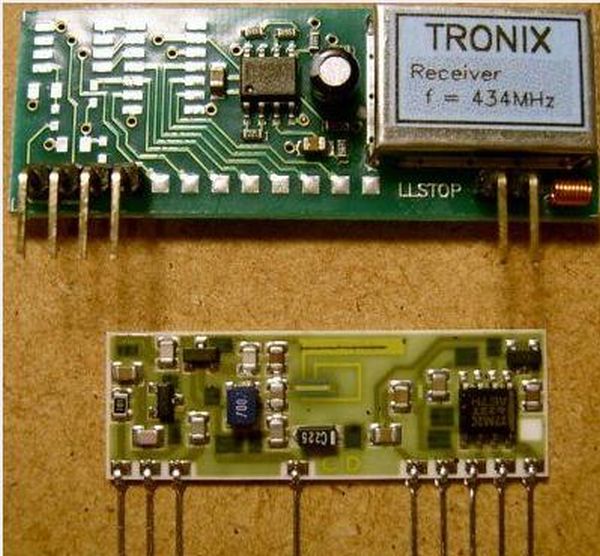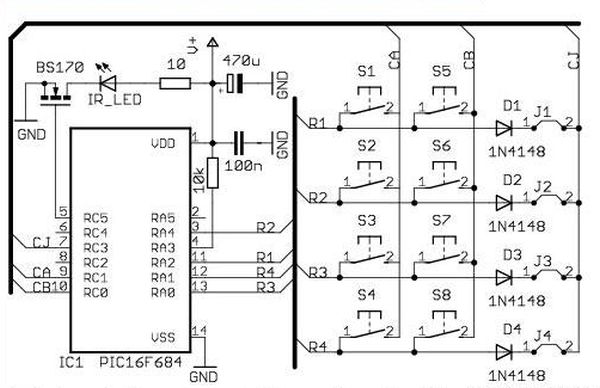Summary of Infra/radio remote control transmitter/receiver with PIC16F630
This project features a general-purpose remote control system using programmable PIC microcontrollers, capable of infrared (IR) or radio frequency (RF) communication. It supports both momentary and latched output channels with varied encoding methods, compatible with up to 8 channels. The system allows addressing to ensure transmitter-receiver matching, and offers flexible button code types like simple, ON, or OFF codes. The receiver utilizes relay outputs and indicates valid signals via an LED. Schematics and source code are provided for 4- and 8-channel versions, with options for IR or RF modules such as TSOP1738 for IR reception.
Parts used in the General Purpose Remote Control Project:
- PIC microcontroller (e.g., PIC16F630)
- Infrared receiver module (e.g., TSOP1738)
- RF transmitter and receiver modules (ASK type)
- Relays with NO/NC contacts for output switching
- Address selection diodes (J1-J4) or switches (S1)
- Push buttons (for 4 or 8 channel control)
- Indicator LEDs (for valid packet reception)
- Encoder/decoder integrated circuits (optional: Holtek HT-12D, HT-12E, Motorola MC145026 series)
- Supporting passive components (resistors, capacitors)
- Power supply components
description
This is a general purpose remote control project with using programmable PIC microcontrollers. Schematics are shown for using infrared (RF) or radio (RF) media. If you are not familiar with microcontroller programming, you can use fixed encoder and decoder integrated circuits instead. Well-known such IC-s are Holtek HT-12D, HT-12E and Motorola MC145026, MC145027, MC145028.
Remote controls usually consist of encoder/decoder parts connected to a transmitter/receiver module which takes care of the transmission of digital signals by radio or infra waves. The format of this project’s signal is designed to be ideal even for the cheapest ASK RF modules (using 50% signal/silence ratio), and it is similar to the Philips RC-5 format used in infrared remote controls. The transmitter has a varying number of buttons and sends the states of these inputs to the receiver. The receiver device decodes the message and sets the outputs accordingly.
general schematic for remote controls
encoder methods
There are two different methods for encoding/decoding channel information:
for remote control – this page is about remote control. The information about which key is pressed is encoded and sent.
You can press at most one key at a time on the encoder, and only the code for the pressed key is sent to the decoder. This is an efficient method for general remote control
parallel channels – please see older codecs for such designs. The state of all inputs are encoded and sent.
The input to the encoder is the state of buttons or TTL inputs. Every input channel state is encoded into each message sent to the decoder (one bit per channel), so TTL inputs can change asynchronously, and any number and combination of buttons can be pressed and encoded, the same state is reproduced on the decoder outputs. This method is suitable for modeling AND remote control, but messages are longer. Analog channels would also be possible, but are not yet implemented
remote control
Current devices have 4 or 8 channels – it means they are capable of controlling the state of 4 or 8 switched outputs. Each transmitter and receiver has an address, and the transmitter address must match the address of the receiver to control the channels. The transmitters are capable of sending three different types of codes for the available channels:
transmitting simple code indicating that the button for a channel is pressed – it can be used for momentary or toggled channel outputs
transmitting channel ON codes – it is used for turning on latched channel outputs
transmitting channel OFF codes – used for turning off latched channel outputs
All the receivers have an indicator LED showing that a valid packet was received. Receivers can have different type outputs for each channel:
momentary output – the channel output is turned ON while the corresponding transmitter button is pressed
latched output – the last received state is kept. The channel output can be toggled on/off by a momentary button press, or the output can be turned on or off by specific ON/OFF-type transmitter codes
Combining different code-type transmitters with receivers with different type channels, great versatility is achieved. The possible combinations are described below. transmitter channel type code receiver channel type resulting behaviour
simple code momentary the channel output is turned ON while the corresponding transmitter button is pressed, and turned OFF when the button is released
simple code latched the channel output state is toggled each time its button is pressed: when the corresponding transmitter button is pressed, the output is turned on. By pressing the same button again, the channel output is turned off
channel ON latched the channel output is turned on when the corresponding transmitter button is pressed
channel OFF latched the channel output is turned off when the corresponding transmitter button is pressed
Current choice of devices:
name channels and types addresses source code
4-channel RF/IR transmitter 4 channels, 8 buttons – each channel has 2 buttons: ON and OFF (for latched receiver operation)
16 (4-bit) 4-ch RF
4-ch IR
8-channel RF/IR transmitter 8 channels, 8 buttons (for toggle or momentary receiver operation) 16 (4-bit) 8-ch RF
8-ch IR
8-channel RF/IR receiver 8 channels: each channel can be latched or momentary 16 (4-bit) 8-ch RF
8-ch IR
4-channel RF/IR receiver 4 channels: each channel has both momentary AND latched outputs (2 outputs per channel) 16 (4-bit) 4-ch RF
4-ch IR
4/8-channel V4.2 RF transmitter
The transmitter has 8 buttons. The 8-channel transmitter can be used for controlling 8 channels by sending simple codes, the 4-channel transmitter can be used with four ON and four OFF buttons for 4 channels. The diode wires (J1-J4) determine the transmitter address. The number of channels (and button functions) depends on the PIC code used.
RF transmitter schematic
4/8-channel V4.2 IR transmitter
The transmitter has 8 buttons. The 8-channel transmitter can be used for controlling 8 channels by sending simple codes, the 4-channel transmitter can be used with four ON and four OFF buttons for 4 channels. The diode wires (J1-J4) determine the transmitter address. The number of channels (and button functions) depends on the PIC code used.
IR transmitter schematic
8-channel V4.2 IR/RF receiver
The receiver has 8 relay-switched NO/NC outputs for 8 channels. Each channel can be set to momentary or latched operation. The address is set by switch S1. The schematic shows the RF version of the receiver, the IR version differs only in the receiver module – a 3-pin IR receiver IC, like TSOP1738 is used
8-channel RF receiver schematic
4-channel V4.2 IR/RF receiver
The receiver has 4 or 8 relay-switched NO/NC outputs for 4 channels. Each channel has both momentary AND latched outputs (2 outputs per channel). LM[0-3] outputs are latched outputs of channels, and LM[4-7] outputs are momentary outputs of channels. The 4-relay PCB can be re-wired to select momentary or latched output for the four relays. The address is set by switch S1. The schematic shows the RF version of the receiver, the IR version differs only in the receiver module – a 3-pin IR receiver IC, like TSOP1738 is used
For more detail: Infra/radio remote control transmitter/receiver with PIC16F630


